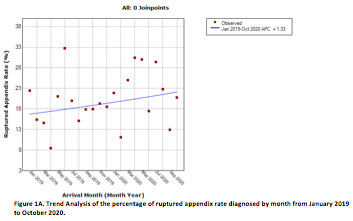Emergency Medicine: All Areas
Category: Abstract Submission
Emergency Medicine IX
377 - Rates of Ruptured Appendicitis Remained Unchanged in Patients Presenting to the Pediatric Emergency Department During the COVID-19 pandemic.
Sunday, April 24, 2022
3:30 PM - 6:00 PM US MT
Poster Number: 377
Publication Number: 377.312
Publication Number: 377.312
Ana M. Ruiz-Castaneda, Nicklaus Children’s Hospital, Miami, FL, United States; Vincenzo Maniaci, Nicklaus Children’s Hospital, miami, FL, United States; Naiomi Cohen, Nicklaus Children’s Hospital, Miami, FL, United States; Juan Lozano, Florida International University Herbert Wertheim College of Medicine, Miami, FL, United States; David Lowe, Nicklaus Children’s Hospital, Miami, FL, United States; Jose M. Vargas Loayza, Nicklaus Children’s Hospital, Miami, FL, United States

Ana M. Ruiz-Castaneda, MD
Pediatric Emergency Medicine Fellow
Nicklaus Children’s Hospital
Miami, Florida, United States
Presenting Author(s)
Background: At the rise of the SARS-CoV2 (COVID-19) pandemic patients appeared to stay home for fear of exposure, potentially delaying medical care. Rates of ruptured appendicitis anecdotally appeared higher during COVID-19 months compared to before the pandemic.
Objective: Assess for association between the COVID-19 pandemic and rates of ruptured appendicitis presenting to a pediatric emergency department (ED).
Design/Methods: Single institution retrospective cohort study of pediatric patients 0-21 years old who presented to the Pediatric ED from January 2019 to October 2020 with an ICD-10 diagnosis of appendicitis. Data was obtained from the electronic medical record database. The COVID-19 time period was defined as April 1, 2020 or later. Ruptured appendicitis was defined by discharge diagnosis ICD-10 codes (K35.21, K35.32, or K35.33) confirmed through manual chart review. For medically managed patients and those who underwent percutaneous drainage, diagnosis of ruptured appendicitis was based on imaging findings (US or CT). For surgically treated patients, diagnosis of ruptured appendicitis was based on operative reports. Multivariate logistic regression was used to assess for association between Covid-19 and ruptured appendicitis, adjusting for potential confounders. Joinpoint regression (version 4.8.0.1) was used to identify time intervals with significant changes in ruptured appendicitis percentage rate.
Results: A total of 1179 patients were included in the analysis. Overall, 237 patients had ruptured appendicitis with 98 of these seen during the Covid-19 period. The mean number of patients with appendicitis seen per day was higher during the pandemic (2.3 per day during vs 1.1 prior) (Table 1). There was no statistically significant difference in the rate of ruptured appendicitis during the pandemic (22.3%) compared to prior (18.8%) (RR 1.19, CI 0.94-1.50) (Table 2). After adjusting for potential confounders, no association was found between the COVID-19 pandemic and the rate of ruptured appendicitis (aOR 1.17, CI 0.71-1.92). Joinpoint analysis detected no change in the trend for the period of COVID-19 and rates of ruptured appendicitis (Figure 1).Conclusion(s): Rates of ruptured appendicitis remained unchanged during the COVID-19 pandemic compared to prior in pediatric patients presenting to the ED.
Unadjusted associations between the period of study (before and during Covid-19) or the baseline characteristics and the outcome (ruptured appendicitis).png)
Figure 1: Trend Analysis of the percentage of ruptured appendix rate diagnosed by month from January 2019 to October 2020
Objective: Assess for association between the COVID-19 pandemic and rates of ruptured appendicitis presenting to a pediatric emergency department (ED).
Design/Methods: Single institution retrospective cohort study of pediatric patients 0-21 years old who presented to the Pediatric ED from January 2019 to October 2020 with an ICD-10 diagnosis of appendicitis. Data was obtained from the electronic medical record database. The COVID-19 time period was defined as April 1, 2020 or later. Ruptured appendicitis was defined by discharge diagnosis ICD-10 codes (K35.21, K35.32, or K35.33) confirmed through manual chart review. For medically managed patients and those who underwent percutaneous drainage, diagnosis of ruptured appendicitis was based on imaging findings (US or CT). For surgically treated patients, diagnosis of ruptured appendicitis was based on operative reports. Multivariate logistic regression was used to assess for association between Covid-19 and ruptured appendicitis, adjusting for potential confounders. Joinpoint regression (version 4.8.0.1) was used to identify time intervals with significant changes in ruptured appendicitis percentage rate.
Results: A total of 1179 patients were included in the analysis. Overall, 237 patients had ruptured appendicitis with 98 of these seen during the Covid-19 period. The mean number of patients with appendicitis seen per day was higher during the pandemic (2.3 per day during vs 1.1 prior) (Table 1). There was no statistically significant difference in the rate of ruptured appendicitis during the pandemic (22.3%) compared to prior (18.8%) (RR 1.19, CI 0.94-1.50) (Table 2). After adjusting for potential confounders, no association was found between the COVID-19 pandemic and the rate of ruptured appendicitis (aOR 1.17, CI 0.71-1.92). Joinpoint analysis detected no change in the trend for the period of COVID-19 and rates of ruptured appendicitis (Figure 1).Conclusion(s): Rates of ruptured appendicitis remained unchanged during the COVID-19 pandemic compared to prior in pediatric patients presenting to the ED.
Unadjusted associations between the period of study (before and during Covid-19) or the baseline characteristics and the outcome (ruptured appendicitis)
.png)
Figure 1: Trend Analysis of the percentage of ruptured appendix rate diagnosed by month from January 2019 to October 2020

